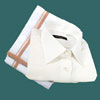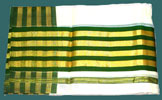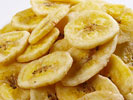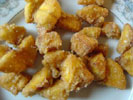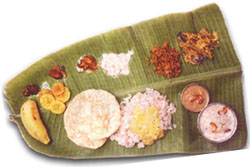Onam Celebration
Onam is the most popular and attractive festival of Kerala, India. It is the harvest festival of Kerala. Irrespective of cast, creed, religion, all Keralites celebrate it now as a national festival of Kerala and it is part of the cultural repertoire of every Malayalee. Onam in the Malayalam month of Chingam (Aug-Sept).
The legend states that Onam is celebrated as the home coming of Mahabali, the king who ruled over Kerala in the age of plenty and all are equal.
Onam Legends states that Onam is celebrated as the home coming of Mahabali, popularly known as Mavely, the king who ruled over Kerala once, "when all men were equal, when no one was poor, when there was neither theft nor dread of thieves"
He was a true devote of the Lord Mahavishnu and was the grandson of the devout Prahalada. The Lord Mahavishnu decided to test the King Mahabali. He came to earth as vamana avathr, as a poor dwarf Brahmin boy. He asked the King Mahabali that he want three feet of land to live. The king laughed and told Vamana to take three feet of land from anywhere he wants.
Suddenly Vamana began to grow and he covered the whole earth by one foot and covered the sky with other foot. And asked Mahabali to give space for the third foot. By seeing all these, the king understood that Vamana is not an ordinary person, and Vamana has come to test him and he showed his head to keep the third foot. Vamana kept his third foot on the King's head and the King was pushed down under the earth (pathala).
Mahabali was an Asura king of Kerala and was very efficient and truthful. During his ruling it is said that there was no thieves, no corruption, no betrayal. And all people lived united, without the difference of rich or poor and all are equal.
He became very popular day by day and the Gods could not be tolerated the popularity of the King Mahabali. They sought help from Lord Vishnu who was worshiped by the King Mahabali.
Lord Vishnu took the avatar of a poor and Brahmin, called Vamana. Vamana was small in size like a boy and came to the kingdom of Mahabali just after his morning prayers, when the King gave boons to Brahmins.
The Vamana asked for as much land as could be covered by his three steps. The King made a promise to do so. Suddenly Vamana began to grow and he covered the whole earth by one foot and covered the sky with other foot. And asked Mahabali where is the space for the third foot.
By seeing all these the king Mahabali realized that the boy was not an ordinary Brahmin and asked Vamana to put his third step on his head with out any hesitation. Then Mahabali was pushed down to the infernal regions (Patala) by Lord Vishnu (Vamana). Mahabali requested permission to visit his people once in a year. Lord Vishnu was pleased to grant the request. Keralites celebrate Onam festival to commemorate the advent of Lord Mahavishnu as Vamana avatar and to rejoice the annual visit of Emperor Mahabali to meet his people. The legend of Onam may also be reflective of beginning of Brahmins/Namboodiris (Vamanan) dominations in Kerala and the fall of native residents (Mahabali) of Kerala of that time.
Keralites Celebrate Onam for 10 days .
The ten days are named as below:- Atham, Chithira, Chodhi, Visakam, Anizham, Thriketa, Moolam, Pooradam, Uthradam, Thiruvonam. There are no set rituals marked for these days.
The Atham day of Chingam, is the first day of the beginning of Onam celebrations. The earthen moulds are made, which look like square pyramids, representing Mahabali and Vishnu and placed in the dung-plastered courtyards, in front of the house and beautifully decorated with flowers.
Athachamayam (September 2, 2008) a cultural procession takes place in the royal town of Tripunithura near Ernakulam, Kochi. Nearest railway station is Thripunithura, about 1 km away. Nearest airport is Cochin International Airport, about 30 km from Thripunithura.
The annual temple festival of the Vamanamoorthy temple at Thrikkakara, also coincides with Onam. The temple is dedicated to Lord Vamana and is linked to the mythological background of Onam.
Boys and girls of the house will get the job of collecting and arranging flowers for the Pookkalm.
The ‘Uunjal aattam’ (swings) is another integral part of Onam, especially in the rural areas. Young men and women, with onakkodi (new dress), sing Onappaattu (Onam songs), and swings one another. The whole hearted enthusiasm and celebrations. Gifts are also procured for everyone in the house including the servants. Some shopping is also done for relatives.
Different types of flowers are added to Pookalam on each day as each flower is devoted to a particular deity. As a result Pookalam increases in diameter on every day and gets a refreshing new design.
One of the important events, which attract foreign guests, is the Snake Boat Race called Vallamkali, which takes place on Anizham the fifth day of the Onam. This popular competition will be held on the banks of the river Pamba at Aranmula.
This colourful spectacle of the race is popularly known as “Aranmula Vallamkali”.
A large number of long snake like boats called chundan vallams participate in Vallamkali. Each picturesquely decorated boat is oared by hundreds of oarsmen dressed in the traditional dhoti and turban. Boats are oared on the rhythm of songs called vanchipattu or boat songs. Vallamkali is essentially a team event any mistake in synchronizing the action by any of the oarsman can lead to overturning of the boat.
Utradam or Uthradam is the ninth and the penultimate day of the festival of Onam. There is jubilation all around as people prepare to welcome the spirit of King Mahabali. In some regions of Kerala festivities of Onam starts in a full-fledged way from Utradam itself and is known as the first Onam and the next day Thiru Onam as the second Onam.
On the day of Utradam tenants and dependents bring produce of their farms or the product to the Karanavar (eldest member of the Tarawad). These gifts from the tenants to the Karanavar are called Onakazhcha.
Karanavar greets these people and treats them with a sumptuous meal on Thiruvonam day.
On thiruonam day activities begin early in the morning. People clean their house, take early bath, wear new clothes and participate in special prayers organized in local temples. Later a very special and the biggest of all days Pookalam, Flower mat, is prepared to welcome the king Mahabali.
Clay mounds in the shape of pyramids representing Lord Vishnu and Mahabali are prepared and placed in front of the Pookalam.
In the noon the grand feast of Onam called Onasadya is prepared. The strict vegetarian meal consists of 11 - 13 mandatory dishes and is served on a banana leaf.
Various cultural events like dances, games and different shows are organized all over the state. Women dressed in their traditional gold-bordered, off-white, ‘mundu and neriyathu’ and performing the very elegant folk dance Kaikottikali is another wonderful scene from the carnival of Onam.
Dances like Kaikottikali and Thumbi Thullal are the important games among women. Fire crackers are also burnt to add fun to the celebration. The eldest member of the family presents gifts and new clothes to the family members.
Onapookkalam is made of various kinds of flowers. Commonly used flowers include Thumba (Lucas Aspera), Kakka Poovu, Thechipoovu, Mukkutti (little tree plant), Chemparathy (shoe flower), Aripoo or Konginipoo (Lantana), Hanuman Kireedom (Red pagoda plant) and Chethi (Ixora). Of all these flowers, Thumba flowers are given more importance in Pookkalam as they are small in size and glitter in the soft rays of the sun.
'Thumba Poo' is also considered to be the favourite flower of Lord Shiva and King Mahabali was a devout worshipper of Shiva.
Various societies and business groups all over the state organize Pookalam decoration competitions (Creating abstract patterns with petals, the floral carpet competition) on the day of Onam.
Big prizes are also offered in these contests as they have turned up to be extremely competitive events. Recently, people prepare intricate designs first on computer and then implement it on floor. This saves a lot of time and energy and helps the designers to come up with stunnin
Tiger Dance-- Kaduva Kali :
Known otherwise as Puli Kali. It is a traditional art form of Kerala performed during festive seasons especially during the Onam season. Performers paint their bodies in bright yellow, red and black spots and lines to resemble tigers, and go about from house to house, dancing vigorously to the loud beating of percussion instruments like Chenda, Udukku, Thakal, etc.
Procession of elephants
The fabulous procession of elephants is one of the major highlights of Onam and attracts thousands of people from India and abroad. A golden plate beatifically designed with different size golden babbles called “Nettippattam” is placed on elephant’s forehead which enhance the elephants look more handsome. The long stemmed ceremonial silk and satin umbrellas laced with white metal or silver are placed on top of the animal. Elephants adorned with gold plates on their forehead and umbrellas on top present a majestic sight. A colourful silk robe, some jewelry and body painting adds to the looks. These pachyderm amuses its audience especially children by shaking its trunk and the big body a little along with the rhythm. The procession is added with feasting, dance, music and merrymaking. The most impressive and good-looking animal gets the honor of being a part of the procession..
Children are particularly excited on Onam as they receive lots of gift from their parents, uncles, aunts, grandparents, family friends and close relatives especially new dresses called Onakkodi .` | ||
| ||
Sending Onam Gifts like dry chips, sweet chips and snacks through courier has become very popular. Online Onam shopping sites exists and many of them have the provision to send Onam Gifts with their own delivery channel. This makes it convenient for the people to send Onam Gifts at desired places around the globe. | ||
|
Onam greetings and messages.
Similar to sending Christmas and New Year greetings, sending of heart felt Onam Messages preferably in Malayalam and onam greeting cards to the near and dear have become very popular.
Thiruonam Aashamsakal to all.
Similar to sending Christmas and New Year greetings, sending of heart felt Onam Messages preferably in Malayalam and onam greeting cards to the near and dear have become very popular.
Thiruonam Aashamsakal to all.
To everyone, my Onam Wishes !
May the spirit of Onam appear everywhere at all times!!
Onaashmsakal to you.
Aayiram Aayiram onasamsakal.
Old Onasmaranakal maathram mathi…..namukku
When ever I remember Kerala, I remember onam & you.
When ever I remember Kerala, I remember onam & you.
Onasadhya or onamsadya (The Meals) is the most favorite and delicious part of the Onam festival. It is considered the most elaborate and grand meal prepared for any festival in the world. |
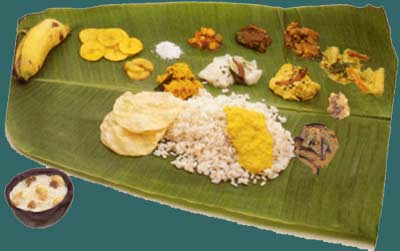 |
| Payasa Mela | ||
There will be 11 essential dishes for Onasadya. Number of dishes may go upto 13. Earlier, Onasaya used to be even more elaborate than depicted above. There were about 64 mandatory dishes - eight varieties each of the eight dishes. At that time three banana leaves were served one under the other to accommodate all the dishes. Onasadya is to be consumed with hands and avoid spoon and fork to enjoy the real taste of Kerala. Rice is the essential and major ingredient of Onam Sadya. There is an old saying “'Kaanam Vittum Onam Unnanam” means “people should prepare Onam Sadya, even selling all there possessions". | ||
| ||
The food has to be served on a tender Banana leaf, laid with the end to the left hand side. The meal is traditionally served on a mat laid on the floor. A strict order of serving the dishes one after another is obeyed. Besides, there are clear directions as to what will be served in which part of the banana leaf.
Major items. Pappad or Pappadum, banana (can be 'Rasakadali', 'Poovan', 'Palayankodan'). - Salt, banana wafers, sarkarapuratti fries, ginger, lime and mango pickles, 'vellarika', 'pavakka', 'beetroot' and 'ulli kitchadi'. 'Kitchadi' made of pineapple and banana splits or of grapes and apple, 'cabbage thoran' or thoran made of beans and avial, bread and green peas mix 'thoran'', kootucurry, 'parippu curry, ghee, Sambhar, Rasam, butter milk, curd, adaprathaman Payasam, erissery,
Kalan or Pulisseri, Olan, Mulakoshyam etc
Kalan or Pulisseri, Olan, Mulakoshyam etc
Onam is round the corner and all are ready to sweeten your Onam festivities with
Paalada
Paal Payasam
Parippu Payasam
Ada Pradhaman
Gothambu Payasam
Vallamkali or the Snake Boat Race is the most enchanting facet of the festival of Onam and an important tourist attraction of the state of Kerala and draws a large number of domestic and international tourists.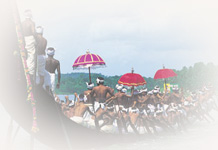 Its popularity is soaring up every year. Major boat races are:Nehru Trophy Boat Race.
Its popularity is soaring up every year. Major boat races are:Nehru Trophy Boat Race.
This biggest and colorful event is held on the Punnamada Backwaters of Alappuzha district on the second Saturday in the month of August. It is Started in the year 1952, in an impromptu fashion in honor of the late Prime Minister, Nehru Trophy Boat Race is the biggest team sport event in the world today. Spectacular boat pageantry held before the actual race is the other highlight of the event.Aranmulla vallam kali.
This colourful spectacle of the race is performed on the banks of the river Pamba at Aranmulla where a temple dedicated to Lord Krishna.
Nearly 30 chundan vallams or snake boats participate in the festival. Singing traditional boat songs, the oarsmen, in white dhotis and turbans, splash their oars into the water to guide their boats to cruise along like a fish on the move. The golden lace at the head of the boat, the flag and the ornamental umbrella at the center make it a spectacular show of pageantry too.Each snake boat belongs to a village along the banks of the River Pampa and is worshipped like a deity. Every year the boat is oiled mainly with fish oil, coconut shell, and carbon, mixed with eggs to keep the wood strong and the boat slippery in the water. The village carpenter carries out annual repairs lovingly and people take pride in their boat, which represents their village and is amed after it.
The one end of the boat is shaped like cobra’s head and it is from this shape that boat has derived its name. Skilled craftsmen and a lot of patience meticulously craft each boat. The boat is about 100 feet long and usually made of anjili (Artocarpus hirsuta), or sometimes teak and kadamb (Naucleacadamba) wood is also used.
Each boat comprises of 150 men of whom four are helmsmen, 25 men are singers and 125 are the actual oarsmen.
Women also participate with lot of enthusiasm in a separate the boat race conducted for them.
Several other boat races at Thalavady, Kumarakam, Mannar, Thiruvandoo, Neerattupuram etc. are also conducted in the various rivers of Kerala and draw massive public attention.




